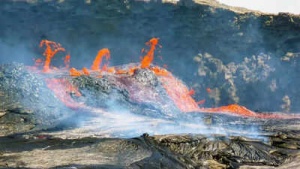NASA's Curiosity rover has delivered unprecedented close-up images of peculiar, web-like rock formations on the Martian surface, offering compelling new insights into the Red Planet's past and its potential for harboring life. These intriguing structures, reminiscent of spiderwebs, are located on the slopes of Mount Sharp within Gale Crater.
These intricate, zig-zagging formations, technically known as "boxwork," are composed of mineral-rich ridges. Scientists believe they are the result of ancient groundwater activity. From an aerial perspective, their pattern resembles delicate webs. The hope is that these formations may hold vital clues about Mars’s ability to support microbial life in the distant past.

Despite their suggestive nickname, these "spiderwebs" are not the work of Martian insects. Instead, they are geological boxwork features. These patterns of intersecting mineral ridges form when groundwater permeates cracks in the rock. As the water evaporates, it leaves mineral deposits. Over eons, wind erosion wears away the softer surrounding rock, exposing the hardened, web-like framework.
While similar boxwork formations have been observed from orbit, this event marks the first time that these features have been closely examined on the Martian surface. Curiosity arrived at this location in early June 2025, following a months-long journey across Mount Sharp. NASA released the images, including a 3D interactive video, on June 23rd, highlighting the formations as a high-priority target due to their unique structure and enigmatic origin.

Analysis of the surrounding rocks reveals the presence of calcium sulfate veins, a salty mineral often left behind by groundwater. This evidence suggests that the area was once abundant in liquid water and that the subsurface environment could have been warm and saline. These conditions bear similarities to environments on early Earth that were conducive to microbial life.
It is important to distinguish these newly imaged boxwork formations from the so-called "spiders on Mars." These dark, radial patterns are caused by carbon dioxide ice erupting from beneath the surface. Unlike these seasonal features, boxwork is permanent and mineral-based, the product of geological processes rather than atmospheric ones.
Scientists speculate that these formations could provide critical evidence in the ongoing debate about whether Mars once supported life. The mineral composition, the protection offered by the underground environment, and the evidence of flowing water all suggest an environment that could have been hospitable to microbial organisms. As Curiosity mission scientist Kirsten Siebach noted, "Early Earth microbes could have survived in a similar environment."
The Curiosity rover will continue its investigation of this boxwork region on Mount Sharp, collecting samples and performing detailed chemical analyses. Researchers anticipate that these unique structures will not only shed light on Mars's climate history but also guide future missions in the search for signs of life beneath the Martian surface.
Newer articles
Older articles
 Moto G54 Gets Significant Price Cut in India, Making Budget Smartphone Even More Appealing
Moto G54 Gets Significant Price Cut in India, Making Budget Smartphone Even More Appealing
 Africa's Rift Valley: Mantle Upwelling Drives Continent's Split and Birth of New Ocean
Africa's Rift Valley: Mantle Upwelling Drives Continent's Split and Birth of New Ocean
 X Cracks Down: Over Half a Million Indian Accounts Suspended for Policy Breaches
X Cracks Down: Over Half a Million Indian Accounts Suspended for Policy Breaches
 Vijay Sethupathi Apologizes Amid Controversy Over Son Surya's Debut Film 'Phoenix'
Vijay Sethupathi Apologizes Amid Controversy Over Son Surya's Debut Film 'Phoenix'
 Jadeja's Accuracy Questioned: Ex-India Pacer Slams Spin Strategy in England Test Loss
Jadeja's Accuracy Questioned: Ex-India Pacer Slams Spin Strategy in England Test Loss
 IRCTC's AI Chatbot Revolutionizes Train Ticket Booking, Refunds, and Information Access
IRCTC's AI Chatbot Revolutionizes Train Ticket Booking, Refunds, and Information Access
 Ashada Gupt Navratri 2025: Unveiling Dates, Sacred Rituals & Hidden Significance of the Monsoon Festival
Ashada Gupt Navratri 2025: Unveiling Dates, Sacred Rituals & Hidden Significance of the Monsoon Festival
 Google Maps Enhances Directional Accuracy with Fused Orientation Provider Update
Google Maps Enhances Directional Accuracy with Fused Orientation Provider Update
 xAI to Open Source Grok, Democratizing Access to Musk's AI Chatbot
xAI to Open Source Grok, Democratizing Access to Musk's AI Chatbot
 Android Users Urged to Patch Now: Critical Security Flaws Expose Devices to Attacks
Android Users Urged to Patch Now: Critical Security Flaws Expose Devices to Attacks